6 July 2017
PDF version [707KB]
Gregory
O'Brien
Statistics and Mapping Section
Executive summary
- This paper, a companion to the Monthly Statistical Bulletin
published by the Parliamentary Library, provides tables and charts for a broad
range of social, demographic and economic indicators across all Australian
states and territories, and compares these with Australian averages.
- Each table presents data for the past five calendar years to 2016,
while each chart plots data for the calendar year 2016.
- The State Statistical Bulletin is published twice per year
covering data for both the previous financial year and calendar year.
Contents
Executive summary
Introduction
Chapter 1: Labour Market
1.1 Employment
1.2 Unemployment
1.3 Labour force
Chapter 2: Wages and Prices
2.1 Average weekly ordinary time
earnings
2.2 Real average weekly ordinary time
earnings
2.3 Male total average weekly
earnings
2.4 Female total average weekly
earnings
2.5 Wage price index
2.6 Consumer price index
Chapter 3: State Accounts
3.1 Real gross state product
3.2 Real gross state product per
capita
3.3 Labour productivity
Chapter 4: Business Conditions
4.1 Value of retail sales
4.2 Passenger vehicle sales
4.3 Dwelling approvals
4.4 Business investment
Chapter 5: Housing
5.1 Lending for owner occupied
housing
5.2 Home loan size
Chapter 6: Public Sector Finances
6.1 State government net debt
6.2 State government fiscal balance
6.3 State government taxation revenue
Chapter 7: Exports
7.1 International merchandise exports
Chapter 8: Social Statistics
8.1 Population
8.2 Apparent school retention rates
8.3 General practice bulk billing
Introduction
The purpose of this paper is to present a
range of economic and other statistical indicators for the states and
territories of Australia. To facilitate comparisons, indicators are presented
in relative terms such as growth rates, percentages, or proportions of gross
state product, so comparisons can be made using equivalent measures.
This publication is a companion to the Monthly
Statistical Bulletin which contains Australia-wide data only, but on a
more frequent basis.
A glossary of social, demographic and economic terms used in
the tables is provided at the end of this publication.
Data
Sources
Data sources are listed at the bottom of the page for each
indicator. All data is from an original ABS series unless otherwise indicated
as a trend or seasonally adjusted series.
Historical
Data
Long-term data series for every table in this paper and for
the Parliamentary Library’s companion publication, the Monthly
Statistical Bulletin, are available electronically and can be found on
the Parliamentary Library’s Monthly Statistical Bulletin and State Statistical
Bulletin pages.
Note: These links can only be accessed by Senators, Members
and parliamentary staff.
Chapter 1: Labour Market
1.1 Employment
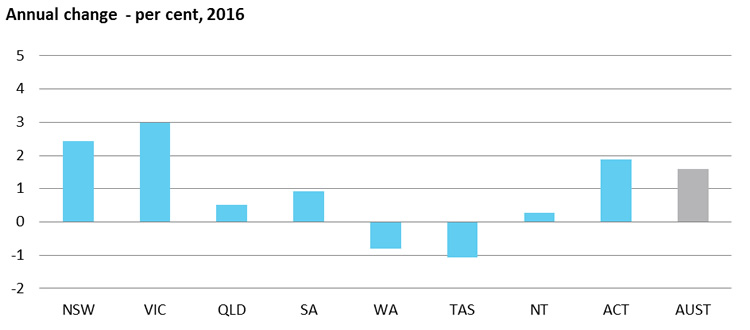
| |
2012 |
2013 |
2014 |
2015 |
2016 |
| Number
employed (a) – '000 |
|
|
|
|
|
| New
South Wales |
3 543.5 |
3 595.0 |
3 617.6 |
3 713.6 |
3 803.8 |
| Victoria |
2 832.0 |
2 854.6 |
2 876.1 |
2 955.6 |
3 043.5 |
| Queensland |
2 284.6 |
2 300.4 |
2 322.3 |
2 342.8 |
2 354.6 |
| South
Australia |
807.5 |
805.1 |
801.3 |
804.3 |
811.6 |
| Western
Australia |
1 309.3 |
1 325.0 |
1 336.7 |
1 351.6 |
1 340.8 |
| Tasmania |
234.4 |
231.5 |
237.5 |
240.2 |
237.7 |
| Northern
Territory |
125.6 |
128.8 |
130.9 |
133.7 |
134.1 |
| Australian
Capital Territory |
210.5 |
210.3 |
209.8 |
209.8 |
213.7 |
| Australia |
11 347.4 |
11 450.8 |
11 532.1 |
11 751.7 |
11 939.8 |
| Annual
change – per cent |
|
|
|
|
|
| New
South Wales |
0.9 |
1.5 |
0.6 |
2.7 |
2.4 |
| Victoria |
0.7 |
0.8 |
0.8 |
2.8 |
3.0 |
| Queensland |
0.6 |
0.7 |
0.9 |
0.9 |
0.5 |
| South
Australia |
-0.1 |
-0.3 |
-0.5 |
0.4 |
0.9 |
| Western
Australia |
5.3 |
1.2 |
0.9 |
1.1 |
-0.8 |
| Tasmania |
-1.8 |
-1.2 |
2.6 |
1.1 |
-1.1 |
| Northern
Territory |
3.5 |
2.6 |
1.6 |
2.2 |
0.3 |
| Australian
Capital Territory |
1.7 |
-0.1 |
-0.2 |
0.0 |
1.9 |
| Australia |
1.2 |
0.9 |
0.7 |
1.9 |
1.6 |
| (a)
Total full-time and part-time employed; Annual average of monthly data. |
| Source:
ABS, Labour Force, Cat. no. 6291.0.55.001, May 2017 |
1.2 Unemployment
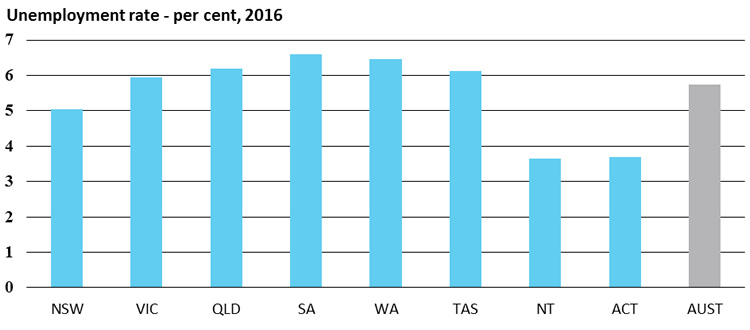
| |
2012 |
2013 |
2014 |
2015 |
2016 |
| Number
unemployed (a) – '000 |
|
|
|
|
| New
South Wales |
188.5 |
212.5 |
220.3 |
227.2 |
205.9 |
| Victoria |
164.6 |
178.1 |
203.0 |
191.7 |
187.9 |
| Queensland |
139.7 |
142.3 |
158.9 |
157.2 |
154.2 |
| South
Australia |
46.8 |
54.2 |
57.5 |
64.1 |
59.3 |
| Western
Australia |
54.3 |
63.9 |
72.8 |
84.7 |
86.9 |
| Tasmania |
17.5 |
19.3 |
18.6 |
17.0 |
16.6 |
| Northern
Territory |
5.5 |
6.9 |
5.5 |
6.0 |
5.4 |
| Australian
Capital Territory |
8.3 |
9.1 |
9.2 |
10.3 |
8.5 |
| Australia |
625.1 |
686.5 |
745.7 |
758.3 |
724.8 |
| Unemployment
rate (b) – per cent |
|
|
|
|
| New
South Wales |
5.1 |
5.7 |
6.1 |
5.3 |
5.1 |
| Victoria |
5.6 |
6.2 |
6.5 |
6.0 |
5.9 |
| Queensland |
6.0 |
6.0 |
6.7 |
6.0 |
6.2 |
| South
Australia |
5.8 |
6.7 |
6.8 |
7.1 |
6.6 |
| Western
Australia |
4.3 |
4.7 |
5.5 |
6.1 |
6.5 |
| Tasmania |
7.1 |
7.7 |
6.7 |
6.6 |
6.1 |
| Northern
Territory |
4.3 |
4.2 |
3.8 |
4.3 |
3.6 |
| Australian
Capital Territory |
4.4 |
3.7 |
4.7 |
4.8 |
3.7 |
| Australia |
5.4 |
5.8 |
6.2 |
5.8 |
5.7 |
| (a)
Annual average of monthly data. |
|
|
|
|
| (b)
Number unemployed as a proportion of the labour force, trend terms, as at
December |
|
| Source: ABS, Labour Force, Cat. no. 6202.0 |
|
|
|
|
1.3 Labour
force
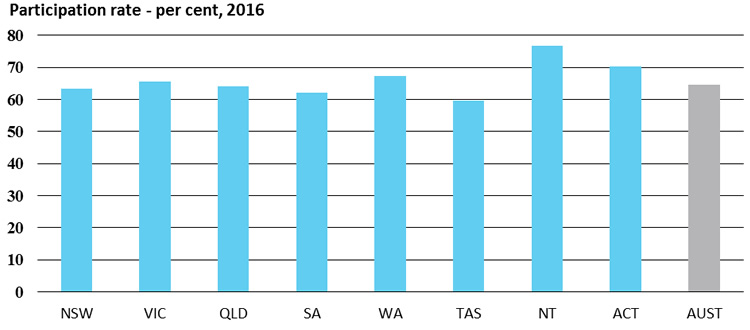
| |
2012 |
2013 |
2014 |
2015 |
2016 |
| Labour
force (a) – '000 |
|
|
|
|
|
| New
South Wales |
3 732.0 |
3 807.5 |
3 837.8 |
3 940.9 |
4 009.7 |
| Victoria |
2 996.5 |
3 032.7 |
3 079.1 |
3 147.4 |
3 231.5 |
| Queensland |
2 424.3 |
2 442.8 |
2 481.2 |
2 500.1 |
2 508.8 |
| South
Australia |
854.3 |
859.3 |
858.8 |
868.4 |
870.9 |
| Western
Australia |
1 363.6 |
1 389.0 |
1 409.5 |
1 436.3 |
1 427.7 |
| Tasmania |
251.9 |
250.8 |
256.1 |
257.2 |
254.3 |
| Northern
Territory |
131.1 |
135.8 |
136.3 |
139.8 |
139.5 |
| Australian
Capital Territory |
218.8 |
219.5 |
219.0 |
220.1 |
222.2 |
| Australia |
11 972.5 |
12 137.2 |
12 277.8 |
12 510.0 |
12 664.6 |
| Participation
rate (b) – per cent |
|
|
|
|
| New
South Wales |
63.4 |
63.0 |
63.0 |
64.3 |
63.3 |
| Victoria |
64.8 |
64.5 |
64.9 |
64.7 |
65.7 |
| Queensland |
66.2 |
65.7 |
65.3 |
65.8 |
64.1 |
| South
Australia |
63.0 |
62.0 |
61.6 |
62.0 |
62.1 |
| Western
Australia |
69.4 |
68.1 |
68.7 |
68.4 |
67.4 |
| Tasmania |
60.4 |
59.7 |
61.3 |
60.5 |
59.8 |
| Northern
Territory |
74.1 |
75.4 |
73.5 |
74.1 |
76.8 |
| Australian
Capital Territory |
72.7 |
71.2 |
70.3 |
70.5 |
70.3 |
| Australia |
65.1 |
64.6 |
64.6 |
65.1 |
64.6 |
| (a)
Annual average of monthly data. |
|
|
|
|
| (b)
Labour force as a proportion of the civilian population aged 15 years and
over, trend series, as at December |
| Source:
ABS, Labour Force, cat. no. 6202.0 |
|
|
|
|
|
|
|
|
|
|
|
|
Chapter 2: Wages and Prices
2.1 Average weekly ordinary time earnings (AWOTE)
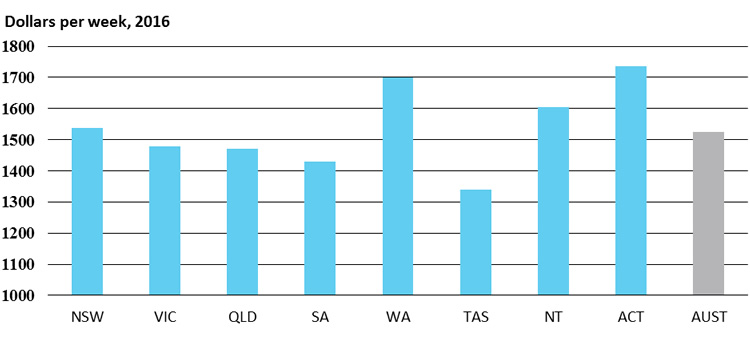
| |
2012 |
2013 |
2014 |
2015 |
2016 |
| AWOTE
(a) (b) – $ per week |
|
|
|
|
|
| New
South Wales |
1 377.1 |
1 414.5 |
1 475.7 |
1 519.7 |
1 538.4 |
| Victoria |
1 314.3 |
1 363.8 |
1 388.4 |
1 410.7 |
1 477.3 |
| Queensland |
1 346.3 |
1 422.8 |
1 447.9 |
1 443.8 |
1 471.2 |
| South
Australia |
1 253.1 |
1 300.6 |
1 352.8 |
1 362.1 |
1 430.5 |
| Western
Australia |
1 553.7 |
1 632.4 |
1 657.2 |
1 700.0 |
1 700.9 |
| Tasmania |
1 211.8 |
1 267.3 |
1 256.8 |
1 303.9 |
1 339.9 |
| Northern
Territory |
1 413.0 |
1 449.1 |
1 435.6 |
1 533.3 |
1 604.1 |
| Australian
Capital Territory |
1 619.6 |
1 687.0 |
1 682.8 |
1 711.3 |
1 736.2 |
| Australia |
1 372.6 |
1 429.0 |
1 465.6 |
1 491.8 |
1 524.7 |
| Annual
change – per cent |
|
|
|
|
|
| New
South Wales |
4.1 |
2.7 |
4.3 |
3.0 |
1.2 |
| Victoria |
3.2 |
3.8 |
1.8 |
1.6 |
4.7 |
| Queensland |
4.6 |
5.7 |
1.8 |
-0.3 |
1.9 |
| South
Australia |
4.2 |
3.8 |
4.0 |
0.7 |
5.0 |
| Western
Australia |
3.6 |
5.1 |
1.5 |
2.6 |
0.1 |
| Tasmania |
4.2 |
4.6 |
-0.8 |
3.7 |
2.8 |
| Northern
Territory |
5.9 |
2.6 |
-0.9 |
6.8 |
4.6 |
| Australian
Capital Territory |
6.4 |
4.2 |
-0.2 |
1.7 |
1.5 |
| Australia |
4.2 |
4.1 |
2.6 |
1.8 |
2.2 |
| (a)
Annual average of bi-annual data. |
|
|
|
|
| (b)
Average weekly ordinary time earnings for full-time adult employees. |
|
|
| Source:
ABS, Average Weekly Earnings, Cat. no.6302.0 |
| Care
should be taken when comparing average weekly earnings of states over time
due to compositional changes |
2.2 Real
average weekly ordinary time earnings
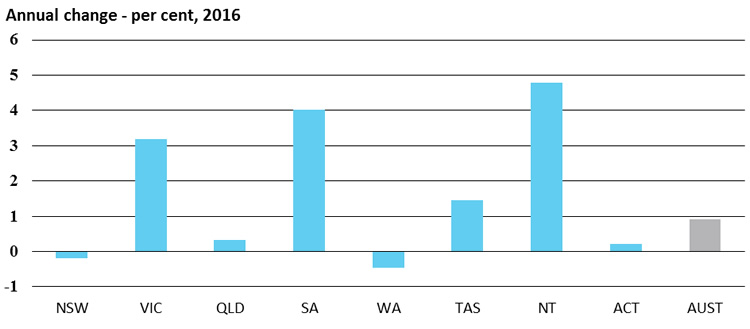
| |
2012 |
2013 |
2014 |
2015 |
2016 |
| Real
AWOTE (a) (b) – $ per week |
|
|
|
|
| New
South Wales |
1 494.0 |
1 496.9 |
1 525.3 |
1 541.5 |
1 538.4 |
| Victoria |
1 429.5 |
1 447.8 |
1 439.8 |
1 443.2 |
1 489.2 |
| Queensland |
1 464.2 |
1 513.8 |
1 499.4 |
1 472.6 |
1 477.6 |
| South
Australia |
1 362.9 |
1 385.0 |
1 405.9 |
1 399.7 |
1 456.0 |
| Western
Australia |
1 689.5 |
1 730.1 |
1 709.3 |
1 730.7 |
1 722.9 |
| Tasmania |
1 324.8 |
1 360.5 |
1 321.2 |
1 356.0 |
1 375.6 |
| Northern
Territory |
1 534.2 |
1 514.6 |
1 458.8 |
1 550.9 |
1 625.2 |
| Australian
Capital Territory |
1 764.6 |
1 800.5 |
1 760.5 |
1 778.9 |
1 782.9 |
| Australia |
1 492.2 |
1 516.3 |
1 517.4 |
1 521.6 |
1 535.5 |
| Annual
change – per cent |
|
|
|
|
|
| New
South Wales |
2.1 |
0.2 |
1.9 |
1.1 |
-0.2 |
| Victoria |
1.5 |
1.3 |
-0.6 |
0.2 |
3.2 |
| Queensland |
3.0 |
3.4 |
-1.0 |
-1.8 |
0.3 |
| South
Australia |
2.4 |
1.6 |
1.5 |
-0.4 |
4.0 |
| Western
Australia |
1.8 |
2.4 |
-1.2 |
1.3 |
-0.5 |
| Tasmania |
3.0 |
2.7 |
-2.9 |
2.6 |
1.4 |
| Northern
Territory |
3.9 |
-1.3 |
-3.7 |
6.3 |
4.8 |
| Australian
Capital Territory |
4.9 |
2.0 |
-2.2 |
1.0 |
0.2 |
| Australia |
2.4 |
1.6 |
0.1 |
0.3 |
0.9 |
| (a)
Annual average. |
|
|
|
|
|
| (b)
Average weekly ordinary time earnings for full-time adult employees expressed
in average 2016 dollars; converted to real terms using the Consumer Price
Index. |
| Sources:
ABS, Average Weekly Earnings, cat. no. 6302.0; ABS, Consumer Price
Index, cat. no. 6401.0 |
| Care
should be taken when comparing average weekly earnings of states over time
due to compositional changes |
2.3 Male total average weekly earnings
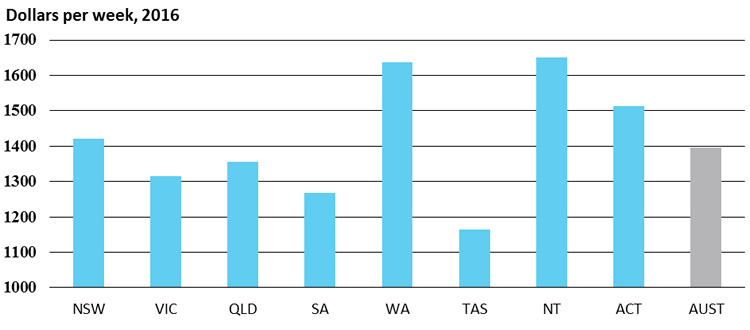
| |
2012 |
2013 |
2014 |
2015 |
2016 |
| MTAWE
(a) (b) – $ per week |
|
|
|
|
|
| New
South Wales |
1 285.0 |
1 313.6 |
1 348.0 |
1 388.8 |
1 421.9 |
| Victoria |
1 222.1 |
1 281.3 |
1 277.1 |
1 278.1 |
1 314.2 |
| Queensland |
1 299.6 |
1 354.8 |
1 352.9 |
1 323.7 |
1 354.8 |
| South
Australia |
1 177.8 |
1 227.7 |
1 280.4 |
1 241.0 |
1 267.9 |
| Western
Australia |
1 585.0 |
1 641.4 |
1 662.0 |
1 657.8 |
1 636.5 |
| Tasmania |
1 081.4 |
1 115.3 |
1 132.1 |
1 163.2 |
1 163.3 |
| Northern
Territory |
1 439.1 |
1 450.7 |
1 436.4 |
1 508.5 |
1 650.2 |
| Australian
Capital Territory |
1 561.6 |
1 545.9 |
1 511.5 |
1 530.4 |
1 513.4 |
| Australia |
1 304.7 |
1 352.3 |
1 368.1 |
1 372.2 |
1 396.5 |
| Annual
change – per cent |
|
|
|
|
|
| New
South Wales |
6.2 |
2.2 |
2.6 |
3.0 |
2.4 |
| Victoria |
2.4 |
4.8 |
-0.3 |
0.1 |
2.8 |
| Queensland |
3.5 |
4.3 |
-0.1 |
-2.2 |
2.3 |
| South
Australia |
5.1 |
4.2 |
4.3 |
-3.1 |
2.2 |
| Western
Australia |
4.6 |
3.6 |
1.3 |
-0.3 |
-1.3 |
| Tasmania |
5.4 |
3.1 |
1.5 |
2.8 |
0.0 |
| Northern
Territory |
6.4 |
0.8 |
-1.0 |
5.0 |
9.4 |
| Australian
Capital Territory |
9.1 |
-1.0 |
-2.2 |
1.3 |
-1.1 |
| Australia |
4.7 |
3.6 |
1.2 |
0.3 |
1.8 |
| (a)
Annual average of bi-annual data. |
|
|
|
|
| (b)
Total average weekly earnings for all male employees. Not adjusted for CPI. |
| Source:
ABS, Average Weekly Earnings, Cat. no. 6302.0 |
2.4 Female total average weekly earnings
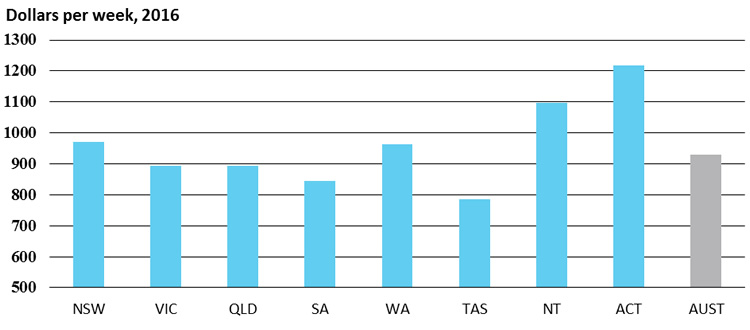
| |
2012 |
2013 |
2014 |
2015 |
2016 |
| FTAWE
(a) (b) – $ per week |
|
|
|
|
|
| New
South Wales |
852.2 |
899.8 |
905.0 |
940.1 |
970.7 |
| Victoria |
801.5 |
823.8 |
843.0 |
867.3 |
892.3 |
| Queensland |
812.1 |
814.5 |
854.9 |
897.5 |
894.0 |
| South
Australia |
757.4 |
793.2 |
856.6 |
836.5 |
844.7 |
| Western
Australia |
840.8 |
903.4 |
943.6 |
959.7 |
963.6 |
| Tasmania |
754.9 |
765.2 |
771.4 |
778.1 |
786.2 |
| Northern
Territory |
986.0 |
1 008.5 |
1 006.6 |
1 048.5 |
1 097.9 |
| Australian
Capital Territory |
1 188.4 |
1 171.1 |
1 160.5 |
1 206.1 |
1 217.5 |
| Australia |
831.0 |
861.3 |
884.6 |
911.3 |
929.1 |
| Annual
change – per cent |
|
|
|
|
|
| New
South Wales |
3.0 |
5.6 |
0.6 |
3.9 |
3.3 |
| Victoria |
3.0 |
2.8 |
2.3 |
2.9 |
2.9 |
| Queensland |
2.2 |
0.3 |
5.0 |
5.0 |
-0.4 |
| South
Australia |
4.9 |
4.7 |
8.0 |
-2.3 |
1.0 |
| Western
Australia |
6.1 |
7.4 |
4.5 |
1.7 |
0.4 |
| Tasmania |
5.4 |
1.4 |
0.8 |
0.9 |
1.0 |
| Northern
Territory |
4.7 |
2.3 |
-0.2 |
4.2 |
4.7 |
| Australian
Capital Territory |
6.9 |
-1.5 |
-0.9 |
3.9 |
0.9 |
| Australia |
3.6 |
3.6 |
2.7 |
3.0 |
2.0 |
| (a)
Annual average of bi-annual data. |
|
|
|
|
| (b)
Total average weekly earnings for all female employees. Not adjusted for CPI |
| Source: ABS, Average Weekly Earnings, Cat. no. 6302.0 |
2.5 Wage price index
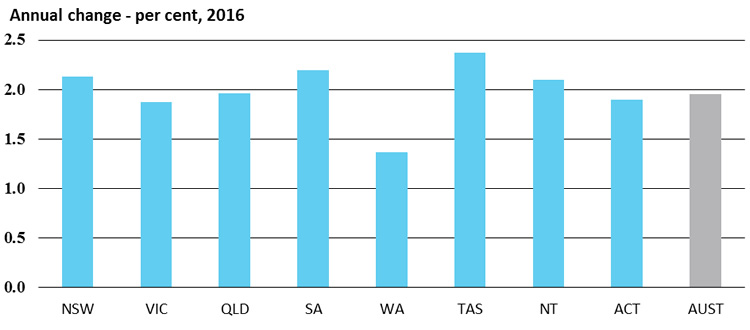
| |
2012 |
2013 |
2014 |
2015 |
2016 |
| Wage
price index (a) (b) |
|
|
|
|
|
| New
South Wales |
114.0 |
116.8 |
119.6 |
122.1 |
124.7 |
| Victoria |
113.9 |
116.7 |
120.0 |
122.9 |
125.2 |
| Queensland |
114.4 |
117.3 |
120.3 |
122.6 |
125.0 |
| South
Australia |
113.2 |
117.2 |
120.2 |
123.0 |
125.7 |
| Western
Australia |
116.0 |
119.5 |
122.3 |
124.5 |
126.2 |
| Tasmania |
114.2 |
116.7 |
119.6 |
122.2 |
125.1 |
| Northern
Territory |
115.1 |
117.8 |
121.1 |
124.0 |
126.6 |
| Australian
Capital Territory |
114.8 |
117.5 |
119.5 |
121.4 |
123.7 |
| Australia |
114.3 |
117.2 |
120.2 |
122.7 |
125.1 |
| Annual
change – per cent |
|
|
|
|
|
| New
South Wales |
3.2 |
2.5 |
2.4 |
2.1 |
2.1 |
| Victoria |
3.5 |
2.5 |
2.8 |
2.4 |
1.9 |
| Queensland |
3.1 |
2.5 |
2.6 |
1.9 |
2.0 |
| South
Australia |
3.1 |
3.5 |
2.6 |
2.3 |
2.2 |
| Western
Australia |
4.3 |
3.0 |
2.3 |
1.8 |
1.4 |
| Tasmania |
3.3 |
2.2 |
2.5 |
2.2 |
2.4 |
| Northern
Territory |
3.2 |
2.3 |
2.8 |
2.4 |
2.1 |
| Australian
Capital Territory |
4.3 |
2.4 |
1.7 |
1.6 |
1.9 |
| Australia |
3.4 |
2.5 |
2.6 |
2.1 |
2.0 |
| (a)
Index value at December |
|
|
|
|
|
| (b)
Total hourly rate of pay index excluding bonuses, all sectors. Base: 2008–09
= 100.0. |
| Source:
ABS, Wage Price Index, Cat. no. 6345.0 |
2.6
Consumer price index
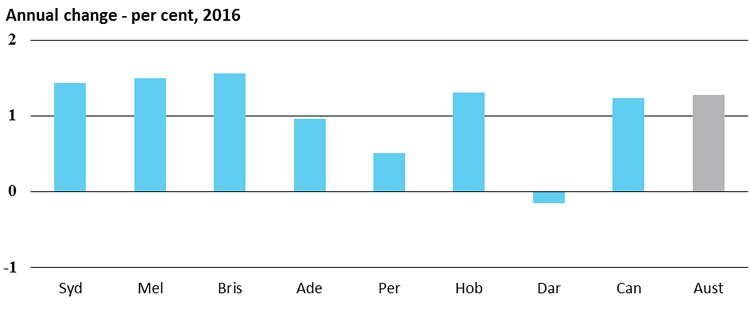
| |
2012 |
2013 |
2014 |
2015 |
2016 |
| Consumer
price index (a) |
|
|
|
|
|
| Sydney |
101.2 |
103.8 |
106.3 |
108.3 |
109.8 |
| Melbourne |
101.0 |
103.5 |
105.9 |
107.4 |
109.0 |
| Brisbane |
101.0 |
103.2 |
106.1 |
107.7 |
109.4 |
| Adelaide |
101.0 |
103.1 |
105.7 |
106.9 |
107.9 |
| Perth |
101.0 |
103.6 |
106.5 |
107.9 |
108.4 |
| Hobart |
100.5 |
102.3 |
104.5 |
105.6 |
107.0 |
| Darwin |
101.2 |
105.1 |
108.1 |
108.6 |
108.4 |
| Canberra |
100.8 |
102.9 |
105.0 |
105.7 |
107.0 |
Weighted
average eight
capital cities |
101.0 |
103.5 |
106.1 |
107.7 |
109.1 |
| Annual
change – per cent (b) |
|
|
|
|
| Sydney |
2.0 |
2.5 |
2.4 |
1.9 |
1.4 |
| Melbourne |
1.6 |
2.5 |
2.4 |
1.4 |
1.5 |
| Brisbane |
1.5 |
2.2 |
2.7 |
1.5 |
1.6 |
| Adelaide |
1.7 |
2.1 |
2.5 |
1.1 |
1.0 |
| Perth |
1.8 |
2.6 |
2.8 |
1.3 |
0.5 |
| Hobart |
1.2 |
1.8 |
2.1 |
1.1 |
1.3 |
| Darwin |
2.0 |
3.9 |
2.9 |
0.5 |
-0.2 |
| Canberra |
1.5 |
2.1 |
2.0 |
0.6 |
1.2 |
Weighted
average eight
capital cities |
1.8 |
2.4 |
2.5 |
1.5 |
1.3 |
| (a)
Annual average of quarterly data; base year for CPI is 2011-12 |
| (b)
Change in the annual averages of table above. |
| Source:
ABS, Consumer Price Index, Cat. no. 6401.0 |
Chapter 3: State Accounts
3.1 Real gross state product
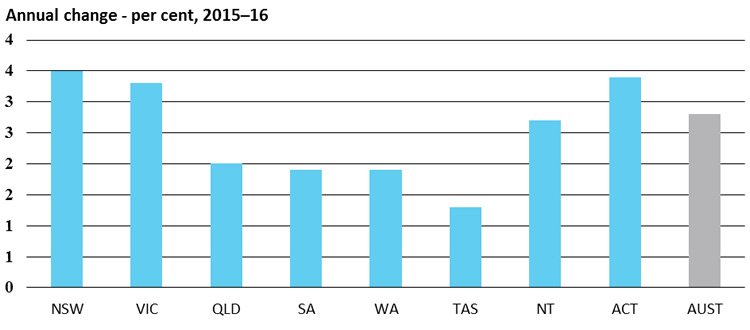
| |
2011-12 |
2012-13 |
2013-14 |
2014-15 |
2015-16 |
| Gross
state product, chain volume measures – $ million |
|
|
|
| New
South Wales |
479 485 |
488 691 |
500 306 |
513 529 |
531 323 |
| Victoria |
346 133 |
349 871 |
352 512 |
361 669 |
373 624 |
| Queensland |
288 233 |
295 096 |
304 874 |
308 448 |
314 569 |
| South
Australia |
94 897 |
96 483 |
97 336 |
99 237 |
101 096 |
| Western
Australia |
216 029 |
228 425 |
241 579 |
250 377 |
255 214 |
| Tasmania |
25 112 |
24 925 |
25 370 |
25 695 |
26 039 |
| Northern
Territory |
19 001 |
21 999 |
22 591 |
23 032 |
23 648 |
| Australian
Capital Territory |
33 398 |
34 278 |
34 567 |
35 029 |
36 225 |
| Australia |
1 500 084 |
1 538 634 |
1 578 784 |
1 617 016 |
1 661 739 |
| Annual
change – per cent |
|
|
|
|
|
| New
South Wales |
1.8 |
1.9 |
2.4 |
2.6 |
3.5 |
| Victoria |
1.8 |
1.1 |
0.8 |
2.6 |
3.3 |
| Queensland |
6.0 |
2.4 |
3.3 |
1.2 |
2.0 |
| South
Australia |
0.7 |
1.7 |
0.9 |
2.0 |
1.9 |
| Western
Australia |
9.1 |
5.7 |
5.8 |
3.6 |
1.9 |
| Tasmania |
0.1 |
-0.7 |
1.8 |
1.3 |
1.3 |
| Northern
Territory |
2.3 |
15.8 |
2.7 |
2.0 |
2.7 |
| Australian
Capital Territory |
1.6 |
2.6 |
0.8 |
1.3 |
3.4 |
| Australia |
3.6 |
2.6 |
2.6 |
2.4 |
2.8 |
| Source:
ABS, Australian National Accounts: State Accounts, Cat. no. 5220.0 |
|
|
| Note:
Gross state product is only published on a financial year basis. |
|
|
|
3.2 Real
gross state product per capita
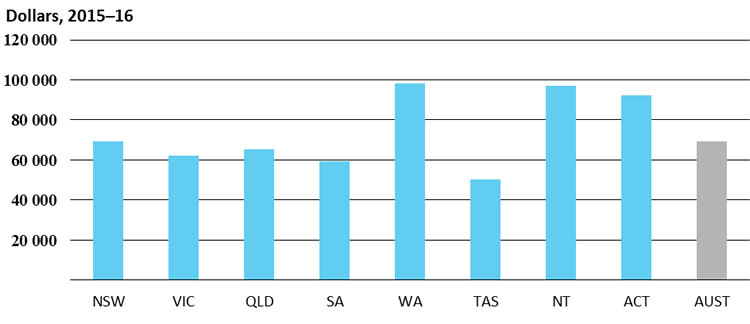
| |
2011-12 |
2012-13 |
2013-14 |
2014-15 |
2015-16 |
| Gross
state product per capita, chain volume measures (a) – $ |
|
|
|
| New
South Wales |
66 030 |
66 427 |
67 069 |
67 886 |
69 266 |
| Victoria |
62 001 |
61 591 |
60 938 |
61 440 |
62 308 |
| Queensland |
63 788 |
64 028 |
65 073 |
64 949 |
65 416 |
| South
Australia |
57 620 |
58 045 |
58 053 |
58 664 |
59 371 |
| Western
Australia |
90 329 |
92 125 |
95 246 |
97 312 |
98 012 |
| Tasmania |
49 053 |
48 636 |
49 362 |
49 864 |
50 327 |
| Northern
Territory |
81 654 |
91 932 |
93 027 |
94 709 |
96 906 |
| Australian
Capital Territory |
89 995 |
90 700 |
90 179 |
90 341 |
92 173 |
| Australia |
66 620 |
67 138 |
67 810 |
68 486 |
69 421 |
| Annual
change – per cent |
|
|
|
|
|
| New
South Wales |
0.7 |
0.6 |
1.0 |
1.2 |
2.0 |
| Victoria |
0.2 |
-0.7 |
-1.1 |
0.8 |
1.4 |
| Queensland |
4.1 |
0.4 |
1.6 |
-0.2 |
0.7 |
| South
Australia |
-0.2 |
0.7 |
0.0 |
1.1 |
1.2 |
| Western
Australia |
5.8 |
2.0 |
3.4 |
2.2 |
0.7 |
| Tasmania |
-0.2 |
-0.9 |
1.5 |
1.0 |
0.9 |
| Northern
Territory |
1.3 |
12.6 |
1.2 |
1.8 |
2.3 |
| Australian
Capital Territory |
-0.1 |
0.8 |
-0.6 |
0.2 |
2.0 |
| Australia |
2.0 |
0.8 |
1.0 |
1.0 |
1.4 |
| Source:
ABS, Australian National Accounts: State Accounts, Cat. no. 5220.0 |
|
| Note:
Gross state product is only available for financial years |
3.3 Labour productivity
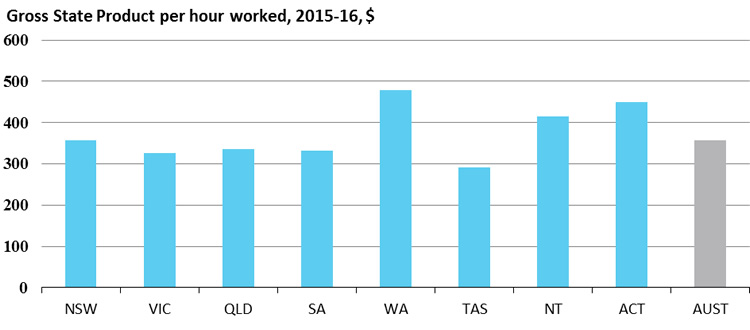
| |
2011-12 |
2012-13 |
2013-14 |
2014-15 |
2015-16 |
| Gross
State Product per hour worked, $ |
|
|
|
|
| New
South Wales |
350.5 |
354.3 |
353.3 |
364.8 |
357.2 |
| Victoria |
324.1 |
329.4 |
320.1 |
329.8 |
326.2 |
| Queensland |
316.4 |
328.7 |
325.7 |
335.0 |
335.2 |
| South
Australia |
311.6 |
320.4 |
317.4 |
323.9 |
332.0 |
| Western
Australia |
423.8 |
435.5 |
451.8 |
465.7 |
477.5 |
| Tasmania |
289.9 |
298.3 |
295.9 |
294.2 |
291.8 |
| Northern
Territory |
364.4 |
413.0 |
401.5 |
415.0 |
414.0 |
| Australian
Capital Territory |
422.4 |
435.5 |
437.9 |
445.3 |
449.5 |
| Australia |
343.8 |
350.7 |
349.1 |
359.8 |
357.0 |
| Annual
change – per cent |
|
|
|
|
|
| New
South Wales |
2.6% |
1.1% |
-0.3% |
3.3% |
-2.1% |
| Victoria |
3.8% |
1.6% |
-2.8% |
3.0% |
-1.1% |
| Queensland |
4.8% |
3.9% |
-0.9% |
2.8% |
0.1% |
| South
Australia |
2.5% |
2.8% |
-0.9% |
2.0% |
2.5% |
| Western
Australia |
4.8% |
2.8% |
3.7% |
3.1% |
2.5% |
| Tasmania |
3.0% |
2.9% |
-0.8% |
-0.5% |
-0.8% |
| Northern
Territory |
1.7% |
13.4% |
-2.8% |
3.4% |
-0.3% |
| Australian
Capital Territory |
2.5% |
3.1% |
0.6% |
1.7% |
0.9% |
| Australia |
4.4% |
2.0% |
-0.5% |
3.1% |
-0.8% |
| (a)
Gross state product (chain volume measures) per hour worked, all sectors
(i.e. market and non-market sectors) |
| Source:
ABS, Australian national accounts: state accounts, Cat. no. 5220.0 |
ABS,
Labour force, detailed, Cat. no. 6291.0.55.001
Note:
Gross state product is only published on a financial year basis |
Chapter 4: Business Conditions
4.1 Value of retail sales
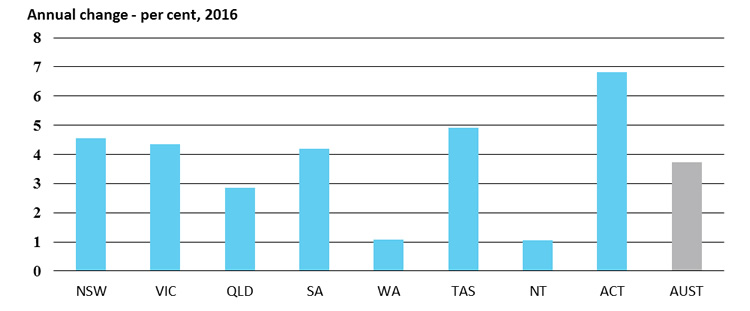
| |
2012 |
2013 |
2014 |
2015 |
2016 |
| Value
– $ million |
|
|
|
|
|
| New
South Wales |
78 656 |
81 772 |
88 813 |
93 698 |
97 953 |
| Victoria |
64 221 |
65 574 |
69 613 |
73 320 |
76 508 |
| Queensland |
53 544 |
55 900 |
57 682 |
59 585 |
61 284 |
| South
Australia |
17 415 |
17 559 |
18 187 |
19 017 |
19 813 |
| Western
Australia |
31 223 |
32 205 |
32 797 |
33 687 |
34 052 |
| Tasmania |
5 111 |
5 187 |
5 550 |
5 760 |
6 042 |
| Northern
Territory |
2 877 |
2 953 |
3 080 |
3 092 |
3 124 |
| Australian
Capital Territory |
4 766 |
4 950 |
5 002 |
5 233 |
5 589 |
| Australia |
257 813 |
266 100 |
280 724 |
293 391 |
304 365 |
| Annual
change – per cent |
|
|
|
|
|
| New
South Wales |
2.7 |
4.0 |
8.6 |
5.5 |
4.5 |
| Victoria |
1.3 |
2.1 |
6.2 |
5.3 |
4.3 |
| Queensland |
5.0 |
4.4 |
3.2 |
3.3 |
2.9 |
| South
Australia |
0.7 |
0.8 |
3.6 |
4.6 |
4.2 |
| Western
Australia |
9.6 |
3.1 |
1.8 |
2.7 |
1.1 |
| Tasmania |
-1.2 |
1.5 |
7.0 |
3.8 |
4.9 |
| Northern
Territory |
4.2 |
2.7 |
4.3 |
0.4 |
1.0 |
| Australian
Capital Territory |
4.1 |
3.9 |
1.0 |
4.6 |
6.8 |
| Australia |
3.4 |
3.2 |
5.5 |
4.5 |
3.7 |
| Source:
ABS, Retail Trade Australia, Cat. no. 8501.0 |
4.2 Passenger vehicle sales
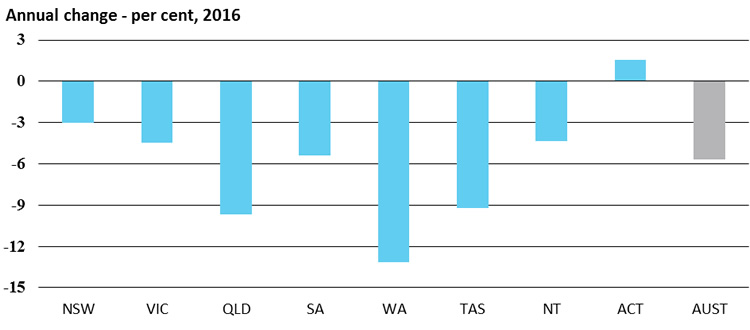
| |
2012 |
2013 |
2014 |
2015 |
2016 |
| Number
(a) |
|
|
|
|
|
| New
South Wales |
185 080 |
181 248 |
176 060 |
176 714 |
171 326 |
| Victoria |
163 856 |
163 282 |
152 200 |
146 173 |
139 667 |
| Queensland |
107 664 |
105 113 |
98 380 |
98 821 |
89 282 |
| South
Australia |
36 296 |
35 843 |
34 173 |
31 078 |
29 406 |
| Western
Australia |
60 206 |
57 080 |
49 800 |
42 602 |
36 998 |
| Tasmania |
8 625 |
9 325 |
7 601 |
7 662 |
6 958 |
| Northern
Territory |
4 320 |
4 226 |
3 917 |
3 585 |
3 430 |
| Australian
Capital Territory |
10 808 |
10 337 |
9 471 |
9 048 |
9 190 |
| Australia |
576 855 |
566 454 |
531 602 |
515 683 |
486 257 |
| Annual
change – per cent |
|
|
|
|
|
| New
South Wales |
1.4 |
-2.1 |
-2.9 |
0.4 |
-3.0 |
| Victoria |
3.7 |
-0.4 |
-6.8 |
-4.0 |
-4.5 |
| Queensland |
2.4 |
-2.4 |
-6.4 |
0.4 |
-9.7 |
| South
Australia |
0.4 |
-1.2 |
-4.7 |
-9.1 |
-5.4 |
| Western
Australia |
10.6 |
-5.2 |
-12.8 |
-14.5 |
-13.2 |
| Tasmania |
-0.7 |
8.1 |
-18.5 |
0.8 |
-9.2 |
| Northern
Territory |
3.0 |
-2.2 |
-7.3 |
-8.5 |
-4.3 |
| Australian
Capital Territory |
5.0 |
-4.4 |
-8.4 |
-4.5 |
1.6 |
| Australia |
3.1 |
-1.8 |
-6.2 |
-3.0 |
-5.7 |
| (a)
Includes vehicles designed primarily for the carriage of people, such as
cars, station wagons and people movers. Also includes four wheel drive
passenger vehicles not classified as sports utility vehicles. |
| Source:
ABS, Sales of New Motor Vehicles, Cat. no. 9314.0 |
4.3 Dwelling approvals
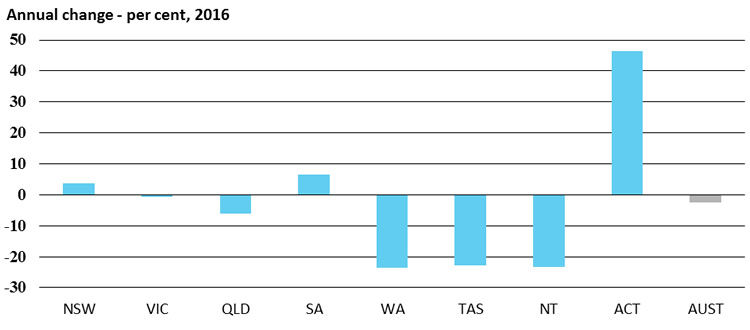
| |
2012 |
2013 |
2014 |
2015 |
2016 |
| Number
(a) |
|
|
|
|
|
| New
South Wales |
38 828 |
49 175 |
55 584 |
71 493 |
74 093 |
| Victoria |
52 121 |
49 833 |
60 895 |
68 669 |
68 284 |
| Queensland |
28 938 |
35 932 |
40 173 |
50 626 |
47 577 |
| South
Australia |
8 375 |
10 652 |
11 778 |
11 365 |
12 093 |
| Western
Australia |
21 690 |
28 690 |
33 088 |
28 660 |
21 865 |
| Tasmania |
2 010 |
1 898 |
2 551 |
2 781 |
2 148 |
| Northern
Territory |
1 920 |
2 294 |
2 000 |
1 666 |
1 278 |
| Australian
Capital Territory |
3 794 |
4 801 |
3 938 |
4 222 |
6 183 |
| Australia |
157 676 |
183 275 |
210 007 |
239 482 |
233 521 |
| Annual
change – per cent |
|
|
|
|
|
| New
South Wales |
12.8 |
26.6 |
13.0 |
28.6 |
3.6 |
| Victoria |
-0.3 |
-4.4 |
22.2 |
12.8 |
-0.6 |
| Queensland |
4.6 |
24.2 |
11.8 |
26.0 |
-6.0 |
| South
Australia |
-16.7 |
27.2 |
10.6 |
-3.5 |
6.4 |
| Western
Australia |
8.9 |
32.3 |
15.3 |
-13.4 |
-23.7 |
| Tasmania |
-21.4 |
-5.6 |
34.4 |
9.0 |
-22.8 |
| Northern
Territory |
45.2 |
19.5 |
-12.8 |
-16.7 |
-23.3 |
| Australian
Capital Territory |
-31.1 |
26.5 |
-18.0 |
7.2 |
46.4 |
| Australia |
2.6 |
16.2 |
14.6 |
14.0 |
-2.5 |
| (a)
Houses and other dwellings (e.g. flats) intended for long-term residential
use; includes both private and public sector dwellings. |
| Source:
ABS, Building Approvals, Cat. no. 8731.0 |
4.4 Business investment
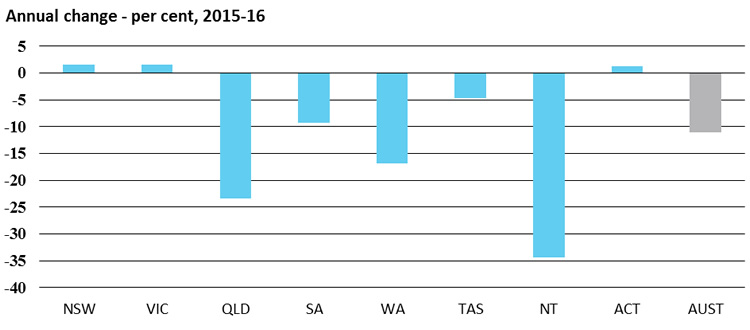
| |
2011-12 |
2012-13 |
2013-14 |
2014-15 |
2015-16 |
| Chain
volume measures (a) – $ million |
|
|
|
|
| New
South Wales |
55 332 |
58 714 |
54 131 |
55 495 |
56 363 |
| Victoria |
41 310 |
37 145 |
40 471 |
43 382 |
44 038 |
| Queensland |
66 784 |
70 323 |
69 199 |
54 227 |
41 555 |
| South
Australia |
12 624 |
12 551 |
12 389 |
12 864 |
11 668 |
| Western
Australia |
74 292 |
78 635 |
70 758 |
62 737 |
52 140 |
| Tasmania |
3 038 |
2 494 |
2 423 |
2 594 |
2 474 |
| Northern
Territory |
5 181 |
10 374 |
11 447 |
12 207 |
8 007 |
| Australian
Capital Territory |
2 703 |
2 762 |
2 266 |
2 339 |
2 369 |
| Australia |
261 411 |
272 897 |
263 013 |
245 845 |
218 615 |
| Annual
change – per cent |
|
|
|
|
|
| New
South Wales |
5.5 |
6.1 |
-7.8 |
2.5 |
1.6 |
| Victoria |
0.7 |
-10.1 |
9.0 |
7.2 |
1.5 |
| Queensland |
41.1 |
5.3 |
-1.6 |
-21.6 |
-23.4 |
| South
Australia |
11.4 |
-0.6 |
-1.3 |
3.8 |
-9.3 |
| Western
Australia |
43.7 |
5.8 |
-10.0 |
-11.3 |
-16.9 |
| Tasmania |
12.0 |
-17.9 |
-2.8 |
7.1 |
-4.6 |
| Northern
Territory |
85.6 |
100.2 |
10.3 |
6.6 |
-34.4 |
| Australian
Capital Territory |
12.1 |
2.2 |
-18.0 |
3.2 |
1.3 |
| Australia |
23.1 |
4.4 |
-3.6 |
-6.5 |
-11.1 |
| (a)
Private business gross fixed capital formation for other buildings and
structures, machinery and equipment, livestock and intangible fixed assets. |
| Source:
Australian National Accounts: State Accounts, Cat. no. 5220.0 |
| Note:
National account data is only available for financial years |
Chapter 5: Housing
5.1 Lending for owner occupied housing
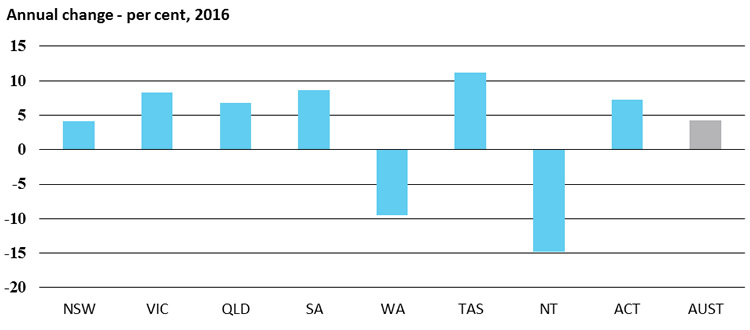
| |
2012 |
2013 |
2014 |
2015 |
2016 |
| Value
(a) – $ million |
|
|
|
|
|
| New
South Wales |
51 919 |
57 956 |
64 369 |
83 386 |
86 782 |
| Victoria |
44 277 |
47 574 |
51 059 |
61 482 |
66 549 |
| Queensland |
29 340 |
32 210 |
35 797 |
38 510 |
41 137 |
| South
Australia |
8 829 |
10 239 |
11 046 |
11 979 |
13 014 |
| Western
Australia |
22 991 |
27 400 |
28 829 |
27 424 |
24 806 |
| Tasmania |
1 927 |
2 128 |
2 392 |
2 463 |
2 738 |
| Northern
Territory |
1 373 |
1 455 |
1 658 |
1 389 |
1 184 |
| Australian
Capital Territory |
2 890 |
3 404 |
3 643 |
4 227 |
4 532 |
| Australia |
163 545 |
182 365 |
198 794 |
230 861 |
240 742 |
| Annual
change – per cent |
|
|
|
|
|
| New
South Wales |
-2.9 |
11.6 |
11.1 |
29.5 |
4.1 |
| Victoria |
1.4 |
7.4 |
7.3 |
20.4 |
8.2 |
| Queensland |
8.7 |
9.8 |
11.1 |
7.6 |
6.8 |
| South
Australia |
-2.0 |
16.0 |
7.9 |
8.4 |
8.6 |
| Western
Australia |
19.1 |
19.2 |
5.2 |
-4.9 |
-9.5 |
| Tasmania |
-5.7 |
10.4 |
12.4 |
3.0 |
11.2 |
| Northern
Territory |
22.4 |
6.0 |
14.0 |
-16.2 |
-14.8 |
| Australian
Capital Territory |
2.4 |
17.8 |
7.0 |
16.0 |
7.2 |
| Australia |
3.2 |
11.5 |
9.0 |
16.1 |
4.3 |
| (a)
Lending commitments by all types of lenders for the construction and purchase
of new or established owner occupied dwellings. |
| Source:
ABS, Housing Finance, Cat. no. 5609.0 |
5.2 Home loan size
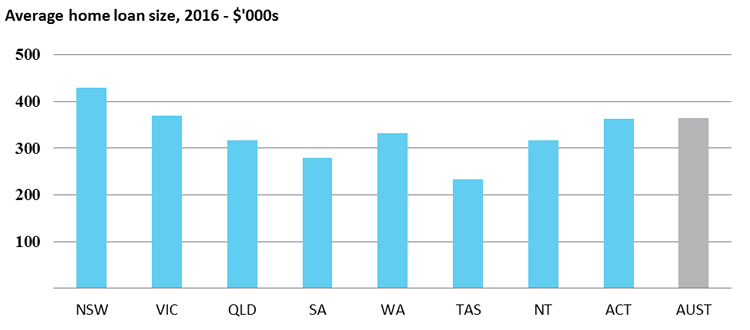
| |
2012 |
2013 |
2014 |
2015 |
2016 |
| Average
size of new owner-occupied home loan (a) – $'000 |
|
|
|
| New
South Wales |
329.7 |
338.7 |
363.3 |
414.1 |
428.3 |
| Victoria |
298.4 |
301.7 |
327.4 |
359.2 |
369.5 |
| Queensland |
283.4 |
280.3 |
294.0 |
307.9 |
316.5 |
| South
Australia |
244.4 |
246.7 |
258.0 |
271.8 |
279.0 |
| Western
Australia |
286.0 |
302.4 |
329.8 |
336.1 |
332.6 |
| Tasmania |
217.4 |
212.4 |
217.1 |
219.4 |
232.6 |
| Northern
Territory |
320.4 |
328.1 |
342.2 |
325.2 |
316.4 |
| Australian
Capital Territory |
334.6 |
325.7 |
325.3 |
347.5 |
362.3 |
| Australia |
298.6 |
303.6 |
324.7 |
354.9 |
363.7 |
| Annual
change – per cent |
|
|
|
|
|
| New
South Wales |
-2.4 |
2.7 |
7.3 |
14.0 |
3.4 |
| Victoria |
-2.0 |
1.1 |
8.5 |
9.7 |
2.9 |
| Queensland |
-1.3 |
-1.1 |
4.9 |
4.7 |
2.8 |
| South
Australia |
-2.1 |
0.9 |
4.6 |
5.4 |
2.6 |
| Western
Australia |
1.9 |
5.7 |
9.1 |
1.9 |
-1.1 |
| Tasmania |
0.3 |
-2.3 |
2.2 |
1.0 |
6.0 |
| Northern
Territory |
5.3 |
2.4 |
4.3 |
-5.0 |
-2.7 |
| Australian
Capital Territory |
0.7 |
-2.6 |
-0.1 |
6.8 |
4.3 |
| Australia |
-1.5 |
1.7 |
7.0 |
9.3 |
2.5 |
| (a)
Includes refinancing, but excludes alterations and additions and refinancing.
Comprises construction of new dwellings and purchase of new and established
dwellings |
| Source:
ABS, Housing Finance, Cat. no. 5609.0 |
Chapter 6: Public Sector Finances
6.1 State government net debt
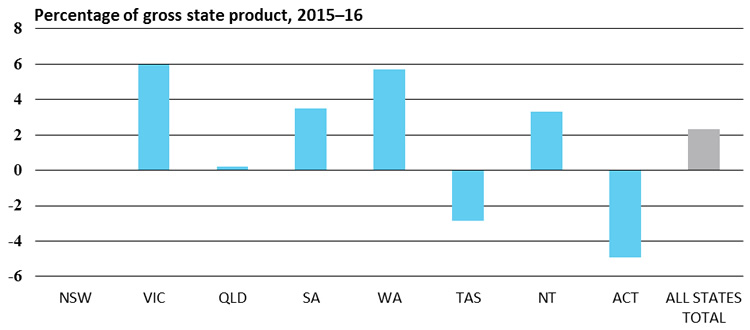
| |
2011-12 |
2012-13 |
2013-14 |
2014-15 |
2015-16 |
| General
government sector net debt (a) – $ million |
|
|
|
| New
South Wales |
13 238 |
10 898 |
5 899 |
5 453 |
195 |
| Victoria |
15 287 |
19 927 |
21 262 |
22 327 |
22 306 |
| Queensland |
-5 865 |
2 513 |
5 184 |
5 752 |
634 |
| South
Australia |
3 401 |
4 459 |
6 296 |
3 108 |
3 486 |
| Western
Australia |
2 050 |
4 742 |
6 973 |
9 306 |
13 717 |
| Tasmania |
- 409 |
- 220 |
- 208 |
- 537 |
- 746 |
| Northern
Territory |
1 633 |
1 829 |
1 811 |
1 133 |
768 |
| Australian
Capital Territory |
-2 733 |
-2 504 |
-2 714 |
-2 427 |
-1 789 |
| Total |
26 603 |
41 643 |
44 503 |
44 115 |
38 572 |
| General
government sector net debt – percentage of gross state product |
|
|
| New
South Wales |
2.8 |
2.3 |
1.2 |
1.1 |
0.0 |
| Victoria |
4.7 |
5.9 |
6.1 |
6.2 |
6.0 |
| Queensland |
-2.0 |
0.9 |
1.7 |
1.9 |
0.2 |
| South
Australia |
3.7 |
4.7 |
6.5 |
3.1 |
3.5 |
| Western
Australia |
0.8 |
1.9 |
2.6 |
3.7 |
5.7 |
| Tasmania |
-1.7 |
-0.9 |
-0.8 |
-2.1 |
-2.9 |
| Northern
Territory |
9.0 |
8.8 |
8.2 |
4.9 |
3.3 |
| Australian
Capital Territory |
-8.4 |
-7.3 |
-7.9 |
-6.9 |
-4.9 |
| Total
(b) |
1.8 |
2.7 |
2.8 |
2.7 |
2.3 |
| (a)
Selected liabilities minus selected assets of the general government sector.
A positive sign therefore indicates that selected liabilities exceed selected
assets; a negative sign indicates that selected assets exceed selected
liabilities. |
| (b)
Total or aggregate net debt for all jurisdictions is expressed as a
percentage of gross state product at current prices. |
| Sources:
ABS, Government Finance Statistics, Cat. no. 5512.0, Australian
National Accounts: State Accounts, Cat, no. 5220.0 |
6.2 State government fiscal balance
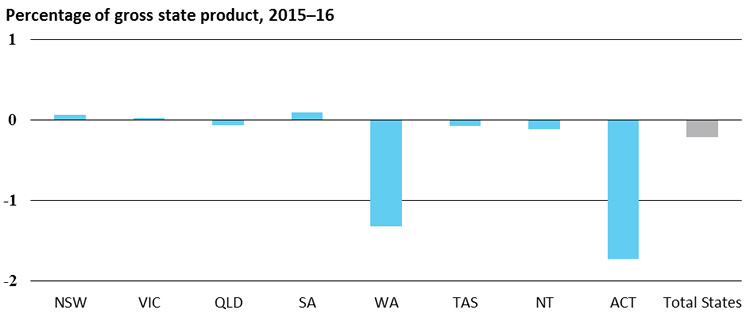
| |
2011-12 |
2012-13 |
2013-14 |
2014-15 |
2015-16 |
| General
government sector fiscal balance (a) – $ million |
|
|
|
| New
South Wales |
-2 099 |
-3 571 |
-1 346 |
612 |
339 |
| Victoria |
-2 091 |
-2 704 |
1 105 |
- 398 |
84 |
| Queensland |
-5 557 |
-7 736 |
-2 587 |
- 530 |
- 201 |
| South
Australia |
-1 102 |
-1 001 |
-1 707 |
- 124 |
97 |
| Western
Australia |
-1 581 |
-1 853 |
-1 127 |
-1 809 |
-3 152 |
| Tasmania |
- 263 |
- 150 |
- 159 |
- 55 |
- 18 |
| Northern
Territory |
- 458 |
- 367 |
- 101 |
- 122 |
- 25 |
| Australian
Capital Territory |
- 336 |
- 755 |
- 575 |
- 912 |
- 628 |
| Total
(b) |
-13 490 |
-18 133 |
-6 494 |
-3 335 |
-3 516 |
| General
government sector fiscal balance – percentage of gross state product |
|
|
| New
South Wales |
-0.5 |
-0.7 |
-0.3 |
0.1 |
0.1 |
| Victoria |
-0.6 |
-0.8 |
0.3 |
-0.1 |
0.0 |
| Queensland |
-1.9 |
-2.7 |
-0.9 |
-0.2 |
-0.1 |
| South
Australia |
-1.2 |
-1.1 |
-1.8 |
-0.1 |
0.1 |
| Western
Australia |
-0.7 |
-0.8 |
-0.4 |
-0.7 |
-1.3 |
| Tasmania |
-1.1 |
-0.6 |
-0.6 |
-0.2 |
-0.1 |
| Northern
Territory |
-2.5 |
-1.8 |
-0.5 |
-0.5 |
-0.1 |
| Australian
Capital Territory |
-1.0 |
-2.2 |
-1.7 |
-2.6 |
-1.7 |
| Total
(c) |
-0.9 |
-1.2 |
-0.4 |
-0.2 |
-0.2 |
| (a)
The financing requirement of government. A positive sign, or fiscal surplus,
indicates a net lending position; a negative sign, or fiscal deficit,
indicates a net borrowing position. |
| (b)
The sum of all state and territory jurisdictions may not agree with the
total, due to transfers between jurisdictions. |
| (c)
Total or aggregate fiscal balance for all jurisdictions is expressed as a
percentage of gross state product. |
| Sources:
ABS, Government Finance Statistics, Cat. no. 5512.0 |
6.3 State
government taxation revenue
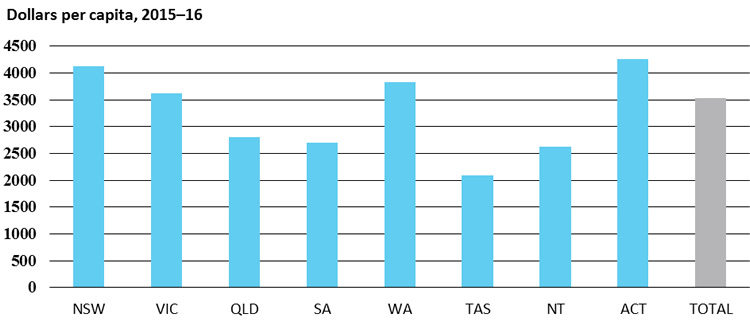
| |
2011-12 |
2012-13 |
2013-14 |
2014-15 |
2015-16 |
| General
government sector taxation revenue – $ million |
|
|
|
| New
South Wales |
20 757 |
22 166 |
24 105 |
26 461 |
29 811 |
| Victoria |
15 136 |
15 629 |
16 995 |
18 436 |
20 027 |
| Queensland |
10 616 |
10 960 |
11 846 |
12 575 |
12 547 |
| South
Australia |
3 869 |
4 112 |
4 107 |
4 393 |
4 426 |
| Western
Australia |
7 125 |
8 170 |
8 594 |
8 772 |
8 997 |
| Tasmania |
888 |
925 |
957 |
1 012 |
1 068 |
| Northern
Territory |
403 |
491 |
566 |
715 |
608 |
| Australian
Capital Territory |
1 183 |
1 237 |
1 296 |
1 377 |
1 568 |
| Total
(a) |
59 976 |
63 689 |
68 465 |
73 739 |
79 053 |
| General
government sector taxation revenue per capita - $ |
|
|
|
| New
South Wales |
3 037 |
3 192 |
3 417 |
3 704 |
4 130 |
| Victoria |
2 937 |
2 973 |
3 164 |
3 376 |
3 616 |
| Queensland |
2 582 |
2 597 |
2 737 |
2 855 |
2 803 |
| South
Australia |
2 463 |
2 588 |
2 553 |
2 700 |
2 699 |
| Western
Australia |
3 383 |
3 762 |
3 836 |
3 829 |
3 823 |
| Tasmania |
1 800 |
1 855 |
1 897 |
1 989 |
2 088 |
| Northern
Territory |
1 885 |
2 233 |
2 504 |
3 112 |
2 629 |
| Australian
Capital Territory |
3 453 |
3 551 |
3 653 |
3 806 |
4 261 |
| Total
(b) |
2 880 |
2 997 |
3 156 |
3 347 |
3 539 |
| (a)
Total is the sum of taxation revenue of all states, not taxation revenue for
Australia. |
|
|
| (b)
Total is the quotient of total taxation revenue (a) and the population of
Australia. This is not equivalent to the taxation revenue per capita for
Australia. |
| Source:
ABS, Taxation Revenue, Cat. no. 5506.0 |
Chapter 7: Exports
7.1 International merchandise exports
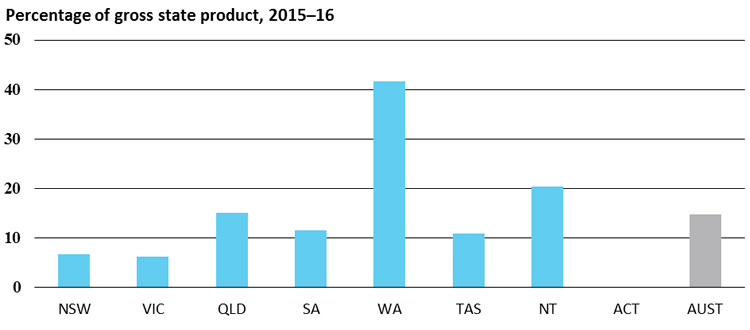
| |
2011-12 |
2012-13 |
2013-14 |
2014-15 |
2015-16 |
| Merchandise
exports (a) – $ million |
|
|
|
|
| New
South Wales |
40 540 |
37 044 |
36 599 |
37 032 |
36 193 |
| Victoria |
21 597 |
21 710 |
23 964 |
23 609 |
23 323 |
| Queensland |
52 868 |
44 433 |
44 813 |
46 488 |
47 867 |
| South
Australia |
11 410 |
10 711 |
12 354 |
11 322 |
11 567 |
| Western
Australia |
120 534 |
115 588 |
130 426 |
110 775 |
99 635 |
| Tasmania |
3 170 |
3 026 |
2 753 |
2 542 |
2 848 |
| Northern
Territory |
5 277 |
5 958 |
6 804 |
6 177 |
4 701 |
| Australian
Capital Territory |
12 |
7 |
1 |
6 |
14 |
| Australia
(b) |
264 018 |
246 978 |
272 922 |
254 552 |
243 423 |
| Merchandise
exports – percentage of gross state product |
|
|
|
| New
South Wales |
8.7 |
7.7 |
7.4 |
7.2 |
6.7 |
| Victoria |
6.6 |
6.4 |
6.9 |
6.5 |
6.2 |
| Queensland |
18.2 |
15.2 |
14.9 |
15.1 |
15.1 |
| South
Australia |
12.5 |
11.4 |
12.7 |
11.4 |
11.5 |
| Western
Australia |
49.8 |
47.1 |
48.6 |
44.2 |
41.6 |
| Tasmania |
13.0 |
12.3 |
10.9 |
9.9 |
10.9 |
| Northern
Territory |
29.1 |
28.8 |
30.9 |
26.8 |
20.4 |
| Australian
Capital Territory |
0.0 |
0.0 |
0.0 |
0.0 |
0.0 |
| Australia
(b) |
17.7 |
16.2 |
17.2 |
15.7 |
14.7 |
| (a)
State in which the final stage of manufacture or production occurs. FOB value |
| (b)
Includes re-exports and state figures not available for publication.
Australian total, therefore, may not equal sum of states and territories. |
| Sources:
ABS, International Trade in Goods and Services, Cat. no. 5368.0; ABS, Australian
National Accounts: State Accounts, Cat. no. 5220.0 Note:
This table is based on national accounts data and is only updated for the
financial year publication |
Chapter 8: Social Statistics
8.1 Population
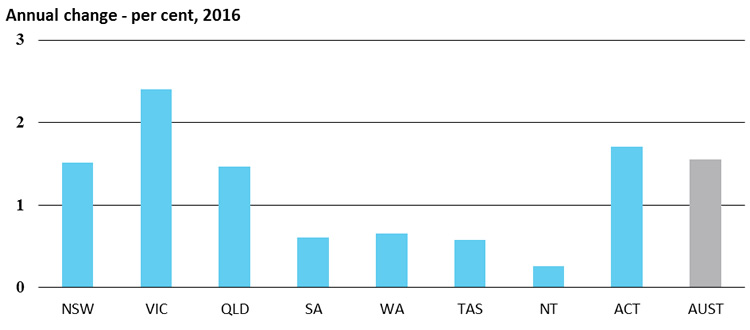
| |
2012 |
2013 |
2014 |
2015 |
2016 |
| Population
(a) – '000 |
|
|
|
|
|
| New
South Wales |
7 358.3 |
7 462.4 |
7 573.1 |
7 681.4 |
7 797.8 |
| Victoria |
5 712.1 |
5 837.8 |
5 966.2 |
6 097.6 |
6 244.2 |
| Queensland |
4 611.3 |
4 688.9 |
4 753.2 |
4 813.3 |
4 883.7 |
| South
Australia |
1 663.2 |
1 678.4 |
1 694.0 |
1 706.6 |
1 717.0 |
| Western
Australia |
2 462.7 |
2 508.2 |
2 533.0 |
2 551.0 |
2 567.8 |
| Tasmania |
512.1 |
513.2 |
514.3 |
516.1 |
519.1 |
| Northern
Territory |
239.4 |
243.1 |
243.2 |
244.4 |
245.0 |
| Australian
Capital Territory |
380.0 |
386.7 |
392.6 |
399.6 |
406.4 |
| Australia |
22 942.2 |
23 321.7 |
23 672.6 |
24 012.8 |
24 385.6 |
| Annual
change – per cent |
|
|
|
|
|
| New
South Wales |
1.3 |
1.4 |
1.5 |
1.4 |
1.5 |
| Victoria |
2.1 |
2.2 |
2.2 |
2.2 |
2.4 |
| Queensland |
2.0 |
1.7 |
1.4 |
1.3 |
1.5 |
| South
Australia |
1.0 |
0.9 |
0.9 |
0.7 |
0.6 |
| Western
Australia |
3.2 |
1.8 |
1.0 |
0.7 |
0.7 |
| Tasmania |
0.0 |
0.2 |
0.2 |
0.3 |
0.6 |
| Northern
Territory |
2.9 |
1.5 |
0.1 |
0.5 |
0.3 |
| Australian
Capital Territory |
2.2 |
1.8 |
1.5 |
1.8 |
1.7 |
| Australia |
1.8 |
1.7 |
1.5 |
1.4 |
1.6 |
| (a)
Estimated resident population numbers are as at December of each year. |
| Source:
ABS, Australian Demographic Statistics, Cat. no. 3101.0 |
8.2 Apparent
school retention rates
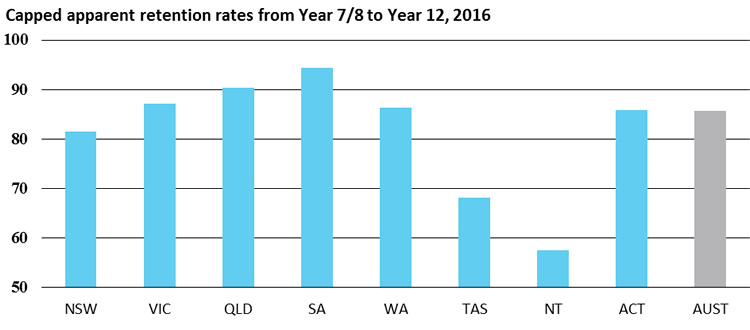
| |
2012 |
2013 |
2014 |
2015 |
2016 |
| Apparent
retention rates from Year 10 to Year 12 (a) |
|
|
|
| New
South Wales |
77.6 |
79.8 |
79.5 |
79.8 |
81.5 |
| Victoria |
85.8 |
85.5 |
85.0 |
86.0 |
87.1 |
| Queensland |
86.2 |
87.9 |
87.0 |
88.5 |
90.1 |
| South
Australia |
85.1 |
87.4 |
89.3 |
90.7 |
92.2 |
| Western
Australia |
79.6 |
79.2 |
79.6 |
82.0 |
85.4 |
| Tasmania |
68.6 |
69.7 |
67.4 |
67.5 |
69.0 |
| Northern
Territory |
54.7 |
58.4 |
55.8 |
60.0 |
68.0 |
| Australian
Capital Territory |
82.6 |
84.3 |
83.8 |
84.4 |
84.8 |
| Australia |
81.9 |
83.1 |
82.8 |
83.7 |
85.5 |
| Apparent
retention rates from Year 7/8 to Year 12 (b) |
|
|
|
| New
South Wales |
76.3 |
78.4 |
78.9 |
80.1 |
81.4 |
| Victoria |
85.4 |
85.8 |
85.8 |
86.2 |
87.1 |
| Queensland |
88.3 |
88.7 |
88.1 |
89.3 |
90.4 |
| South
Australia |
86.3 |
89.8 |
91.7 |
92.9 |
94.4 |
| Western
Australia |
81.7 |
80.7 |
81.1 |
82.3 |
86.4 |
| Tasmania |
69.4 |
70.6 |
68.0 |
67.9 |
68.1 |
| Northern
Territory |
46.3 |
47.8 |
49.1 |
54.9 |
57.5 |
| Australian
Capital Territory |
82.5 |
84.8 |
82.6 |
85.5 |
85.9 |
| Australia |
82.3 |
83.2 |
83.2 |
84.2 |
85.6 |
| (a)
The number of full-time school students in Year 12 expressed as a percentage
of the corresponding group at the commencement of their Year 10 schooling. |
| (b)
The number of full-time school students in Year 12 expressed as a percentage
of the corresponding group at the commencement of their secondary schooling. |
| Source:
ABS, Schools, Cat. no. 4221.0 |
8.3 General practice bulk billing
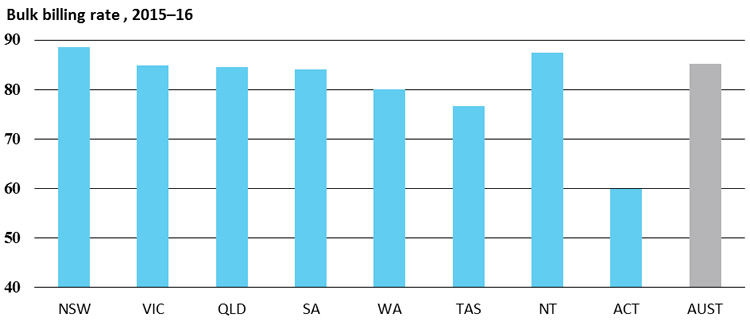
| |
2011-12 |
2012-13 |
2013-14 |
2014-15 |
2015-16 |
| General
practice bulk billing rate (a) – per cent |
|
|
|
| New
South Wales |
85.9 |
86.8 |
87.6 |
88.2 |
88.6 |
| Victoria |
80.5 |
82.0 |
83.1 |
84.0 |
84.8 |
| Queensland |
80.6 |
81.6 |
82.8 |
83.7 |
84.5 |
| South
Australia |
80.5 |
81.3 |
82.3 |
83.3 |
84.0 |
| Western
Australia |
72.4 |
72.9 |
75.3 |
77.8 |
80.1 |
| Tasmania |
74.8 |
76.1 |
77.0 |
77.3 |
76.7 |
| Northern
Territory |
72.0 |
77.4 |
80.7 |
84.5 |
87.4 |
| Australian
Capital Territory |
49.5 |
54.9 |
57.0 |
57.9 |
60.0 |
| Australia |
81.2 |
82.2 |
83.4 |
84.3 |
85.1 |
| (a)
Proportion of general practitioner attendances (excluding practice nurse),
enhanced primary care and other non-referred attendances that are bulk
billed. |
| Source:
Department of Health and Ageing, Annual Medicare Statistics |
Glossary
Apparent school retention rate. The
number of full-time school students in a designated level/year of education
expressed as a percentage of their respective cohort group (which is either at
the commencement of their secondary schooling or Year 10). For a discussion of
‘apparent’ retention rates compared to actual retention rates, see the ABS
source publication, Schools, Australia, 2014 (cat. no. 4221.0)
explanatory notes.
Average weekly earnings. Average gross (before tax)
earnings of employees.
Average weekly ordinary time earnings. Weekly earnings
attributed to award, standard or agreed hours of work.
Business investment. Private gross fixed capital
formation for machinery and equipment; non-dwelling construction; livestock;
and intangible fixed assets.
Consumer price index. A measure of change in the price
of a basket of goods and services from a base period. Changes in the consumer
price index are the most commonly used measures of inflation.
Employed persons. Persons aged 15 and over who, during
a period of one week, worked for one hour or more for pay or worked for one
hour or more without pay in a family business or on a family farm.
General government sector. Government departments and
other entities that provide largely non-market public services and are funded
mainly through taxes and other compulsory levies.
General government sector net debt. Selected
liabilities (deposits held plus proceeds from advances plus borrowing) minus
selected assets (cash and deposits plus investments plus advances outstanding)
of the general government sector.
General government sector fiscal balance. The financing
requirement of the general government sector. A positive sign, or fiscal
surplus, indicates a net lending position; a negative sign, or fiscal deficit,
indicates a net borrowing position.
General practice bulk billing rate. The percentage of
general practitioner attendances (excluding practice nurse) that are bulk
billed.
Gross domestic product. The total market value of goods
and services produced within Australia, after deducting the cost of goods and
services used up in the process of production but before deducting for
depreciation.
Gross state product. Equivalent to gross domestic
product except it refers to production within a state or territory rather than
to the nation as a whole.
Gross state product—chain volume measures. Also known
as real gross state product, this is a measure used to indicate change in the
actual quantity of goods and services produced within a state or territory.
Gross state product per capita. The ratio of the chain
volume measure of gross state product to an estimate of the resident population
in the state or territory.
Job vacancy. A job available for immediate filling and
for which recruitment action has been taken.
Job vacancy rate. The number of job vacancies expressed
as a percentage of the number of employee jobs plus the number of job
vacancies.
Labour force. The employed plus the unemployed.
Labour force participation rate. The number of persons
in the labour force expressed as a percentage of the civilian population aged
15 years and over.
Labour productivity. Gross state product (chain volume
measures) per hour worked, all sectors (that is, market and non-market
sectors).
Male total average weekly earnings. Weekly ordinary
time earnings plus weekly overtime earnings of all male employees. This measure
of earnings is used in the process of benchmarking pensions.
Real average weekly earnings. Average weekly earnings
adjusted for inflation as measured by the Consumer Price Index.
Turnover. Includes retail sales; wholesale sales;
takings from repairs, meals and hiring of goods; commissions from agency
activity; and net takings from gaming machines. Turnover includes the Goods and
Services Tax.
Unemployed persons. Persons aged 15 and over who,
during a period of one week, were not employed but had actively looked for work
in the previous four weeks and were available to start work.
Unemployment rate. The number of unemployed persons
expressed as a percentage of the labour force.
Wage price index. A measure of change in the price of
labour (that is, wages, salaries and overtime) unaffected by changes in the
quality or quantity of work performed.
For copyright reasons some linked items are only available to members of Parliament.
© Commonwealth of Australia
Creative Commons
In essence, you are free to copy and communicate this work in its current form for all non-commercial purposes, as long as you attribute the work to the author and abide by the other licence terms. The work cannot be adapted or modified in any way. Content from this publication should be attributed in the following way: Author(s), Title of publication, Series Name and No, Publisher, Date.
To the extent that copyright subsists in third party quotes it remains with the original owner and permission may be required to reuse the material.
Inquiries regarding the licence and any use of the publication are welcome to webmanager@aph.gov.au.
This work has been prepared to support the work of the Australian Parliament using information available at the time of production. The views expressed do not reflect an official position of the Parliamentary Library, nor do they constitute professional legal opinion.
Any concerns or complaints should be directed to the Parliamentary Librarian. Parliamentary Library staff are available to discuss the contents of publications with Senators and Members and their staff. To access this service, clients may contact the author or the Library‘s Central Enquiry Point for referral.